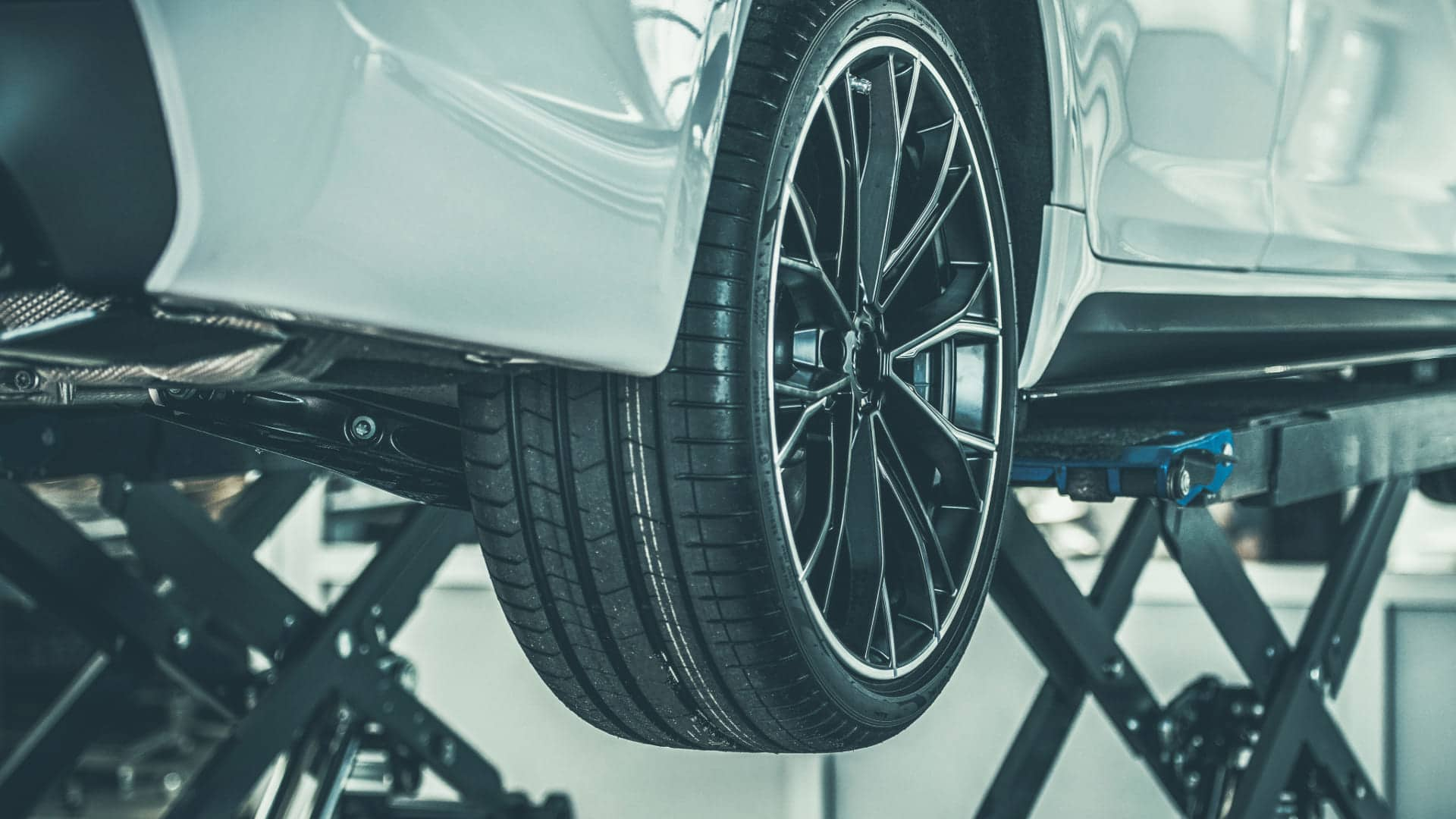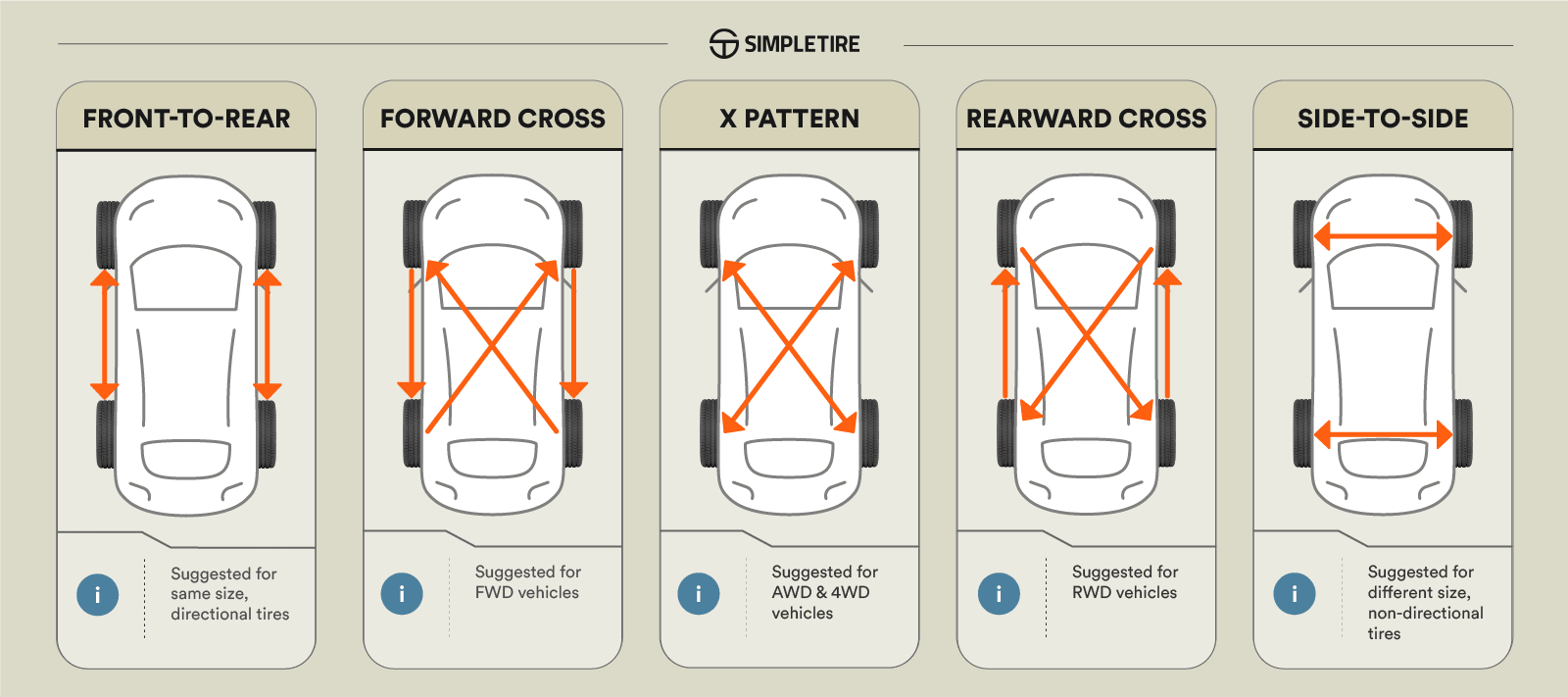Tire Maintenance & Safety
Free shipping
Best price guarantee
Special pricing
Financing with Resolve
Easy returns

Proper tire maintenance is essential for ensuring your vehicle's safety, performance, and longevity. Two crucial aspects of tire care are tire rotation and wheel alignment, both of which play significant roles in maintaining even tire wear and optimal handling.
While often confused or used interchangeably, tire rotation and wheel alignment are distinct services that address different aspects of your vehicle's tire and suspension system. Understanding the differences between these two maintenance tasks can help you make informed decisions about your vehicle's upkeep and avoid costly repairs down the road.
In this article, we'll dive into the specifics of tire rotation and wheel alignment, explaining what each service entails, why they're important, and how often you should have them performed on your vehicle. By the end, you'll have a clear understanding of how these services contribute to your vehicle's overall health and your driving safety.
What is Tire Rotation?

Tire rotation is the practice of periodically changing the position of each tire on your vehicle to promote even wear. This is important because the weight distribution of your vehicle and the forces exerted on each tire while driving are not equal—front tires often bear more weight and are subjected to the additional stresses of steering and braking.
The Importance of Even Tire Wear
Over time, these uneven forces can cause the front tires to wear more quickly than the rear ones. By rotating your tires regularly, you can ensure that all four tires wear at a more consistent rate, which helps to extend their overall lifespan. This not only saves you money on premature tire replacements but also ensures that your vehicle maintains optimal traction and handling characteristics.
Recommended Tire Rotation Intervals
Most vehicle manufacturers recommend rotating your tires every 5,000 to 8,000 miles or at every other oil change. However, it's always best to consult your owner's manual for the specific recommendations for your make and model. Some vehicles, particularly those with unique tire setups or high-performance tires, may require more frequent rotations to maintain even wear.
Common Tire Rotation Patterns
There are several common tire rotation patterns, each designed to suit different vehicle layouts and drivetrain configurations:
- Forward cross: This pattern is recommended for most front-wheel drive vehicles. The rear tires are moved straight forward to the front axle, while the front tires are moved to the opposite sides of the rear axle.
- X-pattern: Suitable for vehicles with non-directional tires, this pattern involves moving each tire to the opposite axle and side of the vehicle. The left front tire moves to the right rear, the right front to the left rear, and vice versa.
- Rear-wheel drive: For rear-wheel drive vehicles, the rear tires are moved straight forward to the front axle, while the front tires are moved to the rear axle on the same side.
By following the appropriate tire rotation pattern for your vehicle at the recommended intervals, you can maximize your tires' lifespan and ensure that your vehicle continues to perform at its best.
What is Wheel Alignment?
Wheel alignment involves fine-tuning the angles of your vehicle's wheels to match the manufacturer's specifications. This adjustment is crucial for ensuring that the tires maintain proper contact with the road, which enhances both handling and safety. Misaligned wheels can compromise vehicle performance and lead to various issues that require attention.
How Misalignment Affects Your Vehicle
Misalignment can significantly impact tire wear, causing it to occur unevenly and more rapidly than usual, which shortens tire life. It can also affect how your vehicle handles, potentially making it feel unstable or causing a drift to one side. Additionally, alignment problems can decrease fuel efficiency due to increased rolling resistance, resulting in higher fuel consumption.
Everyday occurrences such as hitting potholes, bumping into curbs, or driving on uneven surfaces can disrupt your wheel alignment. Symptoms of misalignment often include a steering wheel that vibrates or a vehicle that pulls to one side while driving. Addressing these signs early helps prevent more significant issues down the line.
The Wheel Alignment Process
Adjusting wheel alignment involves setting the camber, caster, and toe angles to precise specifications. This task requires specialized tools to measure and adjust these angles correctly:
- Camber: The vertical tilt of the wheels when viewed from the front. Incorrect camber can lead to uneven tire wear.
- Caster: The angle of the steering pivot as seen from the side, influencing steering stability and cornering.
- Toe: The angle at which the wheels turn inward or outward when viewed from above. Proper toe adjustment is key to avoiding rapid tire wear and maintaining smooth handling.
Wheel alignment machines provide accurate measurements, allowing technicians to make necessary adjustments effectively. This ensures optimal tire contact with the road, improving safety, driving performance, and extending tire life.
When to Get a Wheel Alignment
Regular alignment checks are vital for maintaining your vehicle's performance. If you notice signs like uneven tire wear, pulling to one side, or steering vibrations, it's time for an alignment check. Alignments are also recommended when installing new tires or after significant impacts, such as hitting a pothole or curb. Most manufacturers suggest checking alignment every 12,000 to 15,000 miles or annually to keep your vehicle in top condition.
Tire Rotation vs. Wheel Alignment: What's the Difference?
Tire rotation and wheel alignment each serve unique purposes in maintaining your vehicle's performance and safety. Understanding their differences allows you to schedule these services effectively, ensuring your tires perform optimally.
Tire Rotation
Tire rotation involves changing the position of each tire on your vehicle to ensure balanced wear. Front tires often wear differently than rear tires due to varying loads and driving dynamics. By systematically rotating tires at regular intervals, you can help ensure that all tires wear evenly.
Typically, tire rotation patterns depend on your vehicle's drivetrain and tire type. Following the recommended schedule—usually every 6,000 to 8,000 miles—can lead to better handling, improved traction, and extended tire life. This routine practice is a key component in maintaining consistent vehicle performance and safety.
Wheel Alignment
Wheel alignment focuses on adjusting the angles of your vehicle's wheels to ensure they are set to the manufacturer's specifications. This process corrects issues that may arise from impacts or over time, such as misaligned wheels that can cause uneven tire wear and influence vehicle handling.
During an alignment, technicians adjust the camber, caster, and toe angles to ensure optimal tire-road contact. Signs of misalignment include the vehicle pulling to one side, uneven tire tread, or a vibrating steering wheel. Regular alignments enhance driving comfort, fuel efficiency, and prolong tire life.
Complementary Services
While tire rotation and wheel alignment are distinct services, they work in tandem to maximize tire health and vehicle efficiency. Routine tire rotations can help maintain balance, potentially reducing the need for frequent alignments. Together, they form a comprehensive approach to tire maintenance.
Incorporating both services into your regular maintenance plan can prevent unnecessary wear and extend the lifespan of your tires. This proactive strategy ensures your vehicle remains reliable and performs optimally, supporting your safety and driving satisfaction on the road.
Frequently Asked Questions
Navigating the costs of tire maintenance and the feasibility of DIY options are common inquiries. This section provides clarity to help you make well-informed decisions regarding your vehicle's upkeep.
How much does a tire rotation cost?
The expense of rotating tires can differ based on the service provider. Numerous tire retailers offer no-cost rotations when tires are purchased through them, providing an economical choice. For just a tire rotation service, you might see prices ranging from $20 to $50. Additionally, some service centers bundle tire rotations with regular maintenance tasks like oil changes, presenting an opportunity for added savings.
How much does a wheel alignment cost?
Wheel alignment tends to be pricier than tire rotation due to the intricacy and specialized tools required. Costs generally fall between $50 and $150, influenced by your vehicle's specifics and geographic location. Allocating funds for a proper wheel alignment can be cost-effective over time by averting uneven tire wear and enhancing fuel efficiency. This preventive approach ensures your vehicle operates smoothly and reliably.
Can I perform a tire rotation or wheel alignment at home?
While it's possible to rotate tires at home with the appropriate tools and know-how, leaving this task to professionals often guarantees precision and safety. Conversely, wheel alignments necessitate advanced equipment and precise skills typically found in professional settings. Attempting an at-home alignment could lead to incorrect adjustments, potentially causing further issues or expensive fixes. Opting for professional alignment services ensures your vehicle maintains correct handling and performance standards.
Tire Maintenance Tips for Optimal Performance
Regular tire maintenance is vital to ensure your vehicle's safety and efficiency. By following these simple routines, you can significantly enhance the lifespan and performance of your tires.
Check Tire Pressure Regularly
Ensuring your tires are properly inflated is key to maintaining even wear and optimal fuel efficiency. Tires with incorrect pressure can lead to increased wear or reduced handling performance. Make it a routine to check your tire pressure every month and before any long journeys. Use a dependable gauge for precise measurements and adjust the pressure according to the vehicle manufacturer's guidelines. Don't overlook your spare tire; keeping it at the correct pressure ensures it's ready for use when needed.
Monitor Tread Depth
Having sufficient tread depth is crucial for maintaining traction, particularly in wet conditions. Tires with worn tread can compromise your vehicle's grip, affecting safety. To measure tread depth, use the penny test: insert a penny into the grooves with Lincoln's head facing down. If the top of Lincoln's head is visible, the tread is too worn, and it's time to replace the tire. Replace tires before they reach a tread depth of 2/32 inches to maintain safe driving conditions.
Schedule Routine Maintenance
Incorporating regular vehicle maintenance into your schedule helps ensure your tires remain in top condition. This includes keeping up with oil changes, brake inspections, and other necessary services as recommended by your vehicle's manufacturer. Addressing these maintenance tasks promptly can prevent issues from developing, thus prolonging tire life and enhancing vehicle performance. This proactive approach supports not only your tires but your overall driving experience.
By prioritizing tire rotation, wheel alignment, and regular tire maintenance, you can ensure your vehicle performs at its best while maximizing tire life and safety. At SimpleTire, we are committed to making tire buying and maintenance as simple and affordable as possible. Shop for tires online with us and find the best deals to keep your vehicle running smoothly for miles to come.
There is no particular order that works best since tire rotation and alignment are not interdependent. Usually, drivers go for tire rotation first followed by alignment.
No, tire rotation cannot lead to misalignment as the latter occurs when you have hit a big pothole or any other severe blow to the suspension setup.
Ready to find the perfect tires?
Search By